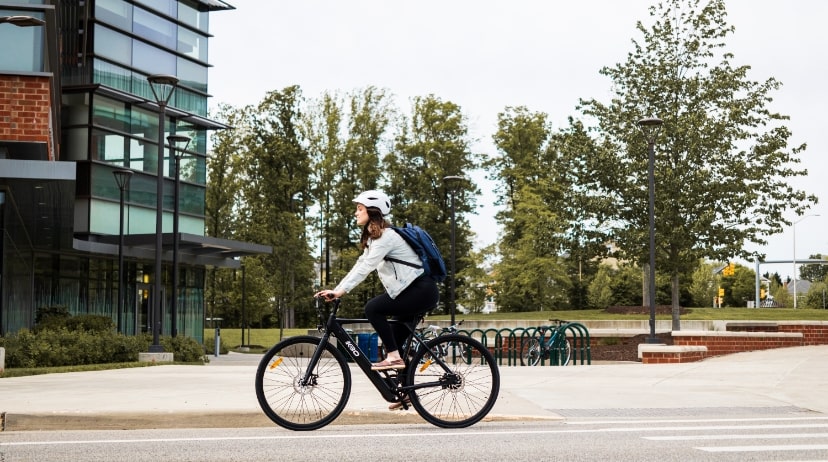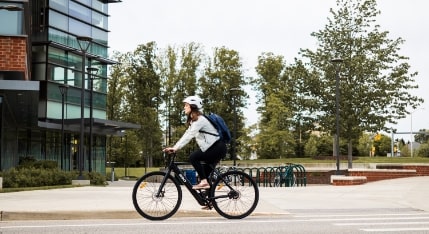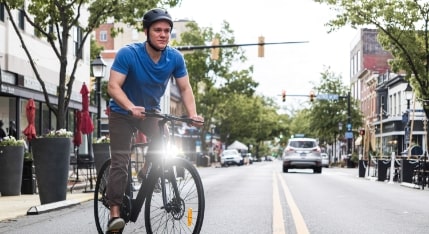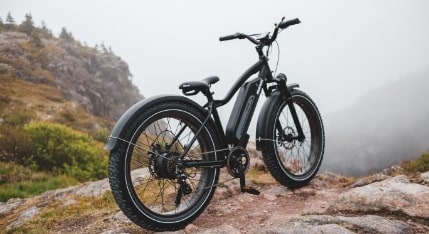The Role of E-Bikes in
Decarbonising Transportation

Chapter 01
The UK’s Net Zero 2050 cycling sustainability targets
We know the way we travel has an impact on the world around us. In fact, transport is the largest contributor to UK domestic greenhouse gas (GHG) emissions, responsible for 27% in 2019. In 2020, the year national lockdowns meant we mainly stayed at home, overall transport carbon dioxide emissions fell by 19.6%.
By law, the UK’s emissions must be net zero by 2050 - a commitment the country has made to reduce the impact of climate change. That’s why decarbonising transport is a huge part of the government’s sustainability plans.
As part of the commitments necessary to reduce emissions, the UK Prime Minister, Boris Johnson, introduced a bold vision for cycling and walking which includes:
Transport is the largest contributor to UK domestic greenhouse gas (GHG) emissions

Investing £2 billion over five years with the aim that half of all journeys in towns and cities will be cycled or walked by 2030

Delivering a world class cycling and walking network in England by 2040
The aim? To increase the shares of trips taken by cycling and walking and make these modes the natural first choice for all who can take them.

Cycling and walking can help us tackle the challenges of climate change, providing:
- 1-6 metric tons (Mt) CO2 savings from 2020 to 2050
- £20-100m worth of air quality benefits by 2050

As well offering other benefits, such as:

£1-4bn gross value added (GVA) in 2050 from manufacture, distribution, sales and repairs of bikes

40k-100k jobs supported in 2050 from manufacture, distribution, sales and repairs of bikes
Increased levels of active daily travel can improve everyday life for all of us – tackling climate change, congestion and noise pollution, as well improving our own health and wellbeing.
Chapter 02
How cycling can help
Decarbonising our daily journeys should be a priority for everyone. According to Decarbonising Transport – A Better, Greener Britain, journeys below five miles represented 58% of all private car journeys in 2019. These are the most obvious opportunities to switch to cycling and walking, which could result in a 68 MtCO2e reduction in current car emissions.
But when the government announced their first Cycling and Walking Investment Strategy, it looked very unlikely that the aim of doubling cycling by 2025 was achievable.
Then the coronavirus pandemic hit.

This increase was greater than across the whole of the previous 20 years and easily the biggest increase in post-war history. The growing number of cyclists sparked a national conversation on transport and proved that a low-carbon commute was possible for many.
Journeys below five miles represented 58% of all private car journeys in 2019

This April saw at least a 50% increase in sales across the whole cycling market"
- Bicycle Association of Great Britain

A Bicycle Association of Great Britain (BAGB) spokesperson told the Energy Advice Hub in 2020: “Early indications are that this April saw at least a 50% increase in sales across the whole cycling market. A survey we did suggests that about 7 in 10 bicycle sales in lockdown are to new or returning cyclists.”
The more people who take up cycling, the greater the potential impact on the environment – especially if they use cycling to replace journeys they used to complete in a car.
7 in 10 bicycle sales in lockdown are to new or returning cyclists
Chapter 03
Top cities which commute by bike
For most of us, the most regular journey we make is the one to and from work. Looking at pre-pandemic data, commuting by bike increased by 42% in 2018, according to Strava. In that year, 46.2 million metric tons of CO2 were offset by people cycling to work.
But where is leading the way?

| Rank | UK City | Most cycling commuters per every 1,000 people |
| 1 | Bristol | 28.9 |
| 2 | Newcastle | 20.8 |
| 3 | Southampton | 16.4 |
| 4 | Leeds | 14.6 |
| 5 | Cardiff | 14.5 |
| 6 | London | 11.9 |
| 7 | Manchester | 7.7 |
| 8 | Liverpool | 6.6 |
Chapter 04
The importance of electric bikes
It’s not always convenient (or easy) to cycle long distances. Electric bikes (or e-bikes) make those journeys much easier because they have a motor to electrically assist your pedalling. As long as an e-bike meets certain criteria, it can be ridden anywhere it’s legal to ride a normal bike. There’s no road tax, no vehicle registration and you don’t need any licenses.
It’s hardly surprising then that people are increasingly interested in e-bikes, with a 47% increase in e-bike searches in 2020 throughout the UK, according to Halfords. Italy was the only major country in the EU to have a greater increase in electric bike search habits.

But is this interest translating into sales? It appears so.
In the first quarter of the company’s 2021 fiscal year, Halfords have seen a 114% YoY sales increase in its e-bikes and e-scooters category.
Further reported statistics reveal the growing popularity of e-bikes has been happening for some time:
There was a 47% increase in e-bike searches in 2020 throughout the UK

One pound in every five spent on bicycles between January and October 2020 was spent on e-bikes

101,362 e-bikes entered the UK in 2019 – a 50.6% increase on the 2018 total of 67,300

125,317 e-bikes had already been imported in just the first ten months of 2020

Halfords predict that by 2050 an estimated 1.5 million e-bikes will be sold within major UK cities in that year
Source: Halfords.com


Electric bicycles can potentially play a big role in cleaning up our transport"
Electric bicycles can potentially play a big role in cleaning up our transport by removing dirty vehicles from our roads and getting people onto two wheels. People who may have previously been unable to travel by bicycle could have an entire new, cleaner way of getting around.
“By getting more people out of their cars we can look to a future where our towns and cities are not choking on polluted air, and climate-wrecking emissions have been slashed.”
- Craig Bennett, Friends of the Earth chief executive
Chapter 05
The environmental impact of bikes and e-bikes
But just how much can bikes and e-bikes reduce our impact on the environment? Well, every bike leaves a carbon footprint in manufacturing, but this carbon cost can be mitigated or entirely offset when it's used to its potential, according to Trek’s sustainability report for 2021. If you ride about 430 miles you would have otherwise driven, you’ve saved the carbon equivalent of what it took to make one of Trek’s most popular bike models.
The carbon emissions produced by bikes and e-bikes is considerably less than cars and electric cars. In fact, there’s no contest, according to data reported by The Guardian.
The European Cycling Federation says the manufacturing footprint of bicycles is 96kg of carbon dioxide equivalent (CO2e). Trek says the production of a basic entry-level mountain bike emits about 100kg of CO2e.
ECF estimates that manufacturing an e-bike has a carbon footprint of 134kg, whereas Trek says its 165kg of CO2e. Either way, it’s much less than the 5.5 tonnes needed to make just one small hatchback, and considerably less than the 13 tonnes which could be needed to make an SUV.
Then there’s the lifetime analysis:

| A typical car | A typical electric car | A conventional bike | An e-bike |
| 220g CO2e/km | 160g CO2e/km | 25-35g CO2e/km | 21-25g CO2e/km |
| 180,000 lifetime kilometres | A lifetime travel of 19,200km | ||
Source: The Guardian
Of course, there are a lot of variables – including a country’s electricity emissions – but it’s clear that bikes and e-bikes offer a considerable opportunity to cut travel emissions. Switching from a daily car journey to an e-bike can save an average 249g of CO2 for every 1km travelled. On a larger scale, if e-bikes were used to replace car travel, they would have the capability to cut CO2 emissions in England by up to 50% (about 30 million tonnes per year).
E-bikes are particularly ideal in helping to transition towards an electric future because they provide a realistic alternative to driving for people who would find it difficult or inconvenient to regularly ride an unassisted bike.
Chapter 06
Glossary
Net zero
When the volume of greenhouse gases being emitted is the same as is being absorbed by offsetting techniques, such as planting trees.
Decarbonisation
The removal or reduction of carbon dioxide output by switching to low carbon energy sources, such as renewables.
E-bike
A combination of a conventional bike and a motor, so that some of the effort of pedalling is reduced. E-bikes can travel greater distances faster with less human effort.









